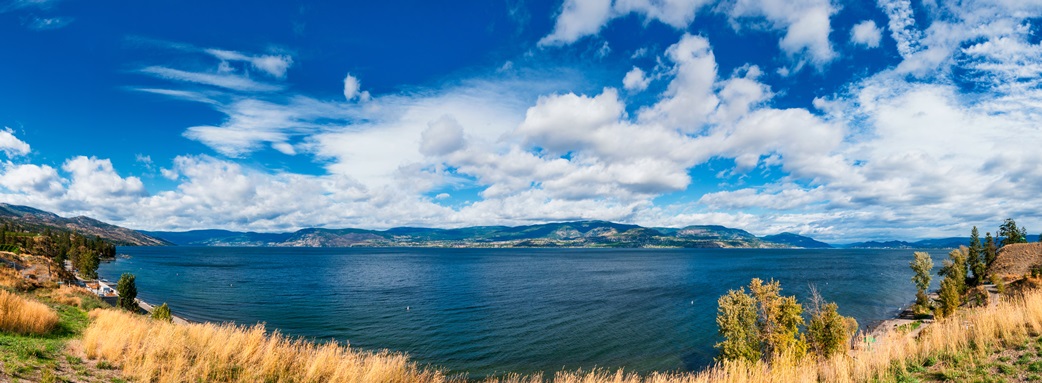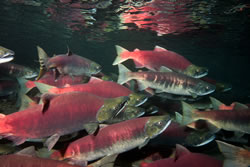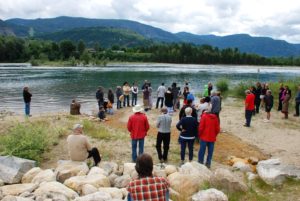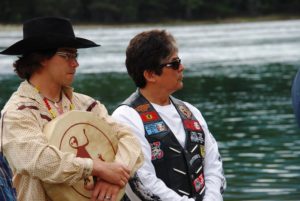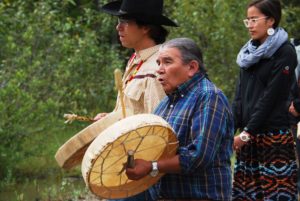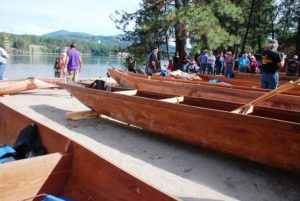One of the mantras of the sustainability movement has long been “people, planet, profit”. When dealing with sustainable development and green technologies, the ways in which benefits accrue to these three areas can sometimes be rather ephemeral and theoretical. But when dealing with restorative development, the benefits are often dramatic and impossible to miss.
Such as the case in the Okanagan Valley of British Columbia, where the return of long-lost salmon is revitalizing the local economy, regenerating the local ecology, and restoring the cultural heritage of the local indigenous people (referred to as “First Nations” in Canada, and as “Native Americans” in the U.S.).
Although the rivers and lakes of the Okanagan Valley once ran silvery blue with the once-abundant Okanagan sockeye salmon, its population was destroyed by a series of man-made engineering disasters, bringing it close to extinction in the mid-1990s.
But now the salmon is back in Osoyoos Lake, in such large numbers that it’s become an exciting new addition to the local food scene. There are so many fish that, in 2014, the recreational and commercial fishery officially opened on the lake, for the first time ever.“It’s such a good news story and when it comes to fisheries, you never have good news stories,” says Ingrid Jarrett, general manager of the Watermark Beach Resort and president of the Thompson Okanagan Slow Food convivium. “Usually, it’s one disaster after another.”
During the summer, 50 to 70 sports fishing boats can often be seen on the lake. The Okanagan Nation Alliance (ONA) – which had “lake to plate in less than 24 hours” as its marketing motto – found a ready local market, with the top chefs at valley wineries vying to outdo each other with fresh, wild salmon offerings.
The ONA brought the sockeye back by restoring habitat in the Okanagan River. How all this came about is the result of an unprecedented collaboration between the Okanagan Nation, the Canadian Department of Fisheries and Oceans, the British Columbia provincial government, local foodies, environmentalists, recreational fishers, tourism experts and consumers on both sides of the Canada-U.S. border.
Okanagan Lake in British Columbia, Canada is called a fjord lake as it has been carved out by repeated glaciations. Although the lake contains numerous lacustrine terraces, it is not uncommon for the lake to be 100m deep only 10m offshore. Major inflows include Mission, Vernon, Trout, Penticton, Equesis, Kelowna, Peachland and Powers Creeks.
The lake is drained by the Okanagan River, which exits the lake’s south end via a canal through the city of Penticton to Skaha Lake, whence the river continues southwards into the rest of the South Okanagan and through Okanogan County, Washington to its confluence with the Columbia.
The lake’s maximum depth is 232 metres near Grant Island (Nahun Weenox). There is one other island known as Rattlesnake Island, much farther south by Squally Point. Some areas of the lake have up to 750 metres of glacial and post-glacial sediment fill which were deposited during the Pleistocene Epoch.
The Columbia-Snake river basin in the United States is the southernmost part of the sockeye salmon range. The vast majority of the run return to the Wenatchee and Okanogan river basins with about 85 percent, return to the Okanagan Basin.
On June 3, 2016, the Okanagan Nation Alliance’s (ONA) kł cp̓əlk̓ stim̓ Hatchery started providing thousands of sockeye salmon fry for ceremonial fry releases taking place at 6 Mile Creek (Vernon), Trout Creek (Summerland), and Mission Creek (Kelowna).The releases are in recognition and celebration of the Syilx peoples’ continued successful efforts to bring sockeye salmon back to the Okanagan, and in particular now to Okanagan Lake. These ceremonies are critical given that sockeye salmon were nearly extinct in the Okanagan Basin.
In the 1960’s the Columbia River Treaty and other developments led to the creation of industrial reservoirs, and the building hydro-electric developments on the Columbia River, making it impossible for fish passage, while deeply impacting Syilx cultural and food systems.
Years of hard work and political advocacy, particularly in the last decade, have seen the ONA working with provincial, federal and US Tribes and agencies to rebuild this sockeye run from 3000 up to 500,000 salmon returning annually.
Grand Chief Stewart Phillip stated that “Our salmon are sacred, and are our constitutional rights. We have been working collaboratively for over a decade with the Department of Fisheries and Oceans Canada, and the Province of BC to study the impacts of Okanagan Sockeye on the ecosystem. The results have proven what we have always known, that these salmon have always been here, and that there are no negative impacts. We are happy to have the support of DFO, yet remain frustrated and confused as to why the Province of BC remains opposed to these efforts”.
These restoration efforts are critical. Last year’s drought and heatwave devastated an expected robust Okanagan sockeye salmon run. In response, Howie Wright, ONA’s Fisheries Manager pointed out that “We now have another cold water lake [after Osoyoos and Skaha Lake] to help us build resilience in sockeye salmon stocks, diversifying the gene stock within each of these lake systems. Based on its size and depth we could see Okanagan Lake with a minimum of 30,000 -100,000 adult spawners per year. On top of that optimistically anywhere from 300,000-.5 million for fisheries harvest would be coming to Okanagan Basin. It has the significant potential to meet food, social, ceremonial needs, providing food security for communities, while seeing a surplus extend to range of biological and economic benefits”.
Elders’ accounts, and other forms of Traditional Ecological Knowledge (TEK) tell us that many species of salmon once came into the Okanagan Valley and tell us how coyote brought salmon up into the Okanagan Basin for the Okanagan people. Historic accounts of sockeye, chinook, coho, and steelhead and potentially others have been documented as returning to the Okanagan.
The primary fishing site on the Okanagan was at Okanagan Falls, as salmon migrated into the Okanagan Basin. Okanagan Elders still remember salmon in the Okanagan system above Okanagan Falls. Government reports dating back to the 1920’s indicate that Okanagan Falls would have been passable for salmon, giving salmon access to Skaha and Okanagan lakes. This is confirmed by “chaptikwl”, Okanagan oral history that is passed through the generations. There is a chaptikwl that tells how Sen’klip (Coyote) brought the salmon up the Columbia River and into its tributaries, which includes the Okanagan Basin.
There is also an almost 100 year history of damming and water diversions in the Okanagan system, with the first dam at the outlet of Okanagan Lake constructed in 1914. The first dam at McIntyre Bluff was constructed in 1921, and a second was replaced in 1954. The government of Canada completed channelization works in the mid-1950s for flood control purposes, and the Okanagan River lost 50% of the overall river length and approximately 90% of its wetland and riparian habitat.
Today, only sockeye salmon return to the Okanagan in significant numbers, but they have been under numerous threats and have been in decline over the last several decades. Since their migration patterns have been altered due to the construction and operation of dams in the Okanagan Basin, the Okanagan’s major salmon fishing ground has moved from Okanagan Falls at the outlet of Skaha Lake dam, to the downstream end of McIntyre Dam at the outlet Vaseux Lake.
There are limited opportunities to harvest salmon due to varying run sizes of adult returns, the changes in their migration timing and environmental conditions that cause extreme temperatures in Okanagan River and its lakes. It is necessary to protect and rebuild the sockeye and also to renew the spiritual and dietary resource that once played a major part in Okanagan culture.
The re-introduction of sockeye salmon into their historic habitat is part of the concept of ecosystem-based recovery of indigenous anadromous salmon populations and habitat restoration in the Okanagan Basin. The return of sockeye salmon into Skaha Lake, is a day of celebration for the Okanagan Nation and its members, because it is the beginning of rebuilding our salmon stocks, so they can harvest salmon once again.
More than 200,000 sockeye salmon fry were released into Okanagan Lake by the ONA over several weeks in the summer of 2016. But the planned fry release will go ahead without the support of the provincial government.
Okanagan Indian Band chief Byron Louis says his band has been working since 1995 to get authority to try and re-introduce the salmon to Okanagan Lake only to come up against many barriers. “We’re so tired of being denied something that was fundamental to our people and our culture,” said Louis. “This is something we subsisted on for generations. It’s such a relief to finally get to this point. We’re not there yet because it’s still going to be about getting the salmon back (once they go to the ocean) but at least they are back to where they belong and that’s in Okanagan Lake. It’s very good and it’s about time. We shouldn’t have had to go through what we did to get to this point.”Fisheries managers with the Okanagan Nation Alliance will release the fry, which have been raised at the ONA’s 25,000 square foot hatchery in Penticton. Similar efforts by the ONA over the past 12 years have resulted in sockeye salmon returning to Skaha Lake in Penticton, including a high of 20,000 sockeye during one return.
The Okanagan Nation Alliance (ONA) was formed in 1981 as the inaugural First Nations government in the Okanagan which represents the 8 member communities including; Okanagan Indian Band, Upper Nicola Band, Westbank First Nation, Penticton Indian Band, Osoyoos Indian Band, Lower and Upper Similkameen Indian Bands, and the Colville Confederated Tribes on areas of common concern. Each community is represented through the Chiefs Executive Council (CEC) by their Chief or Chairman.
Top photo of Okanagan Lake via Adobe Stock.
See Okanagan Nation Alliance website.
See full article by Joanne Sasvari in the Vancouver Sun.
See full article by Kevin Parnell in the Kelowna Capital News.
See 2014 article in The Globe and Mail by Mark Hume.
See full background information on Okanagan Sockeye Reintroduction (PDF).

